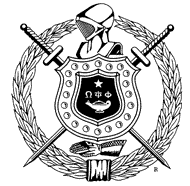 INTERNAL GROWTH
INTERNAL GROWTH
In 1922, Grand Basileus J. Alston Atkins appointed the first District Representatives. Today, there are eleven such officers who are elected annually by the district conferences/meetings. In 1922, the office of Vice Grand Basileus was created. The Grand Keeper of Records became the Grand Keeper of the Records and Seal. The first Omega Bulletin was published in 1928. Campbell C. Johnson was the Editor. "Omega Dear" was adopted as the official hymn in 1931. Two faculty from Howard University, Charles R. Drew, Professor of Surgery, and Mercer Cook, Professor of Languages, were the composers. Cook wrote the music and first stanza; Drew wrote the last two stanzas.
THE FORTIES
The Omega "Sweetheart Song", with words and music by Don Q. Pullen, was adopted as the official sweetheart song by the 1940 Nashville Grand Conclave. Founder Ernest E. Just entered Omega Chapter in 1941. In 1941, Dr. Charles Drew perfected the use of blood plasma as a life saving tool. William Hastie resigned as Civilian Aide to the Secretary of War in protest against discrimination in the Armed Forces. He was later appointed Governor of the Virgin Islands by President Truman. In 1949, the first National Headquarters Building at 107 Rhode Island Avenue, N.W., Washington, D.C. was purchased. H. Carl Moultrie, I was selected to serve as the first National Executive Secretary. In 1949, the scholarship fund was renamed the Charles R. Drew Memorial Scholarship Fund.
THE FIFTIES
During this era, the thrust was social change. Thousands of Omega men in every area of the country were actively involved in the fight to eliminate racial discrimination. An entire book could be written about this phase of Omega activities. The 1955 Los Angeles Grand Conclave initiated a program whereby each graduate chapter would purchase a Life Membership from the NAACP. Between 1955 and 1959, chapters contributed nearly $40,000 to the NAACP. In the fifties, Omega Psi Phi took an official position against hazing as a fraternity activity. This anti-hazing position remains in effect today, and the policy banning hazing has been strengthened.
THE SIXTIES
The struggle for social justice shifted into high gear. Brothers were active participants in the "sit-ins" and other demonstrations designed to call attention to the plight of black Americans. Undergraduate brothers especially were involved in the demonstrative aspect of the civil rights struggle. In 1961, the Washington, D.C. Grand Conclave did an excellent job of highlighting the fifty years of accomplishments by Omega. Brothers attended the 1961 Golden Anniversary Conclave in record numbers. Founders Love, Cooper, and Coleman were present. Thirteen of twenty-three former Grand Basilei were in attendance. Young brothers had the once-in-a-life-time opportunity to mingle with some of the greatest black men that America had produced. The Golden Anniversary Conclave authorized $140,000-$150,000 for the construction of a new National Headquarters Building in Washington, D.C. In 1964, the new National Headquarters Building was dedicated. The building was a dream come true and was the first building of its type to be built by a black fraternity. Founders Love, Cooper and Coleman participated in the ceremonies. The name was later changed to the International Headquarters. It is located at 2714 Georgia Avenue, N.W., Washington, D.C. 20001. Robert H. Lawrence (in 1966) was selected as the first Black to serve in the Astronaut Program. Lawrence had earned a Ph.D. Degree in chemistry at Ohio State University. Founder Frank Coleman entered Omega Chapter in 1967. The 1968 Charlotte Grand Conclave mandated a Constitutional Convention for the revision of the Constitution and By-Laws as well as the Ritual. The Convention was held in Atlanta in 1969.
Other Historical Links:
Chapter History
Notables